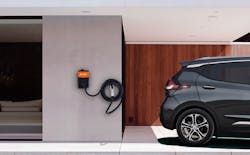EV Charging Trends: Solar Absorption, Demand Response, Green Charging
More and more, electric vehicles (EVs) are being called upon to absorb excess solar energy and provide demand response. These are EV charging trends to watch.
Yet another trend is increased demand from EV drivers for charging based on green energy.
Enel X, which aims to help communities create, store, use and share energy, has a number of projects underway that puts these ideas to the test, said Preston Roper, head of Enel X e-mobility in North America. The company, formerly the EV infrastructure company eMotorWerks, is working on smart charging programs for both utilities and a car manufacturer, Honda.
One of the company’s latest projects aims to time EV charging in Hawaii with high solar production so that the EV batteries make use of solar that might otherwise be wasted.
Under the program, Hawaiian Electric Companies, the state’s largest electricity supplier and Elemental Accelerator, an accelerator that gives funding to pilot and commercial-scale startups, are working with Enel X on Smart Charge Hawai’i. The new program now has an 85% to 90% utility customer opt-in rate, said Roper.
Sign up bonus plus free EV charging stations
The partners are offering EV drivers $30 for signing up and are providing free charging stations from Enel X for 300 residential and 50 commercial units, Roper said. The residential chargers, called JuiceBox, are worth $549 and the commercial chargers are worth about $1,000, he said.
Participants will earn points, redeemable for cash, when they connect to and use the smart charging stations. One of the goals of the program is to measure how smart EV charging can help absorb renewable energy.
Under the program, Enel X software programs the chargers to turn on when prices are most attractive under time of use rates. The company regulates both the time and rate of charging.
“If it’s time of use, it’s configured with the JuiceBox charger and software,” Roper explained.
The idea is that EVs are often sitting in parking lots and driveways during the day — when solar production is highest — and available to charge and absorb excess solar that would otherwise go unused.
The chargers can also be aggregated and controlled to respond to demand response events. A number of utilities are interested in this option, said Roper.
“Different utilities want to understand EV changing and want to set up rates and do demand response programs. They want to shape the load and utilize as much solar as possible.”
In 2018, Enel X began deploying a 30 MW virtual energy storage battery in California, based on distributed EV batteries.
Enel X’s total virtual battery capacity is now 40 MW. Enel X bids all year round into the California Independent System Operator (CAISO) day ahead and real time markets, said a spokeswoman for Enel X.
Over the summer, there were 10 aggregation events June through August and 13.2 more events in September. More than 90% of possible customers participated in the events.
Honda manufacturing facility participating
Not only are utilities interested in smart charging; so are car manufacturers. Honda is now using Enel X’s JuiceNet software in its Honda SmartCharge program.
The program helps owners of the Honda Fit charge when electricity demand is low and when renewable energy production is high.
The Honda SmartCharge program is offered in southern California, and participating EV drivers can earn $50 for signing up and up to $50 more based on their use of the platform over each two-month period.
The program takes smart charging one step further than many smart charging programs. It determines the best times to charge, based on the driver’s daily schedule, the amount of renewable energy being generated and the amount of carbon dioxide emitted from power plants on the grid.
The system allows the vehicle to be fully charged when the drivers need it next, but doesn’t affect how they use their cars.
Under the program, the Enel X system interfaces with California’s grid operator, providing for real-time control that allows EVs to participate in demand response events.
“As we get more cars in place we want as much flexibility for car manufacturers or fleets of cars,” said Roper.
Other EV charging trends to watch
Meanwhile, EV drivers are starting to express interest in green charging. A new Enel X business line, Endesa X, will install public charging in Spain, giving 75% of Spain’s population access to public charging infrastructure. The power supplied to charge the EV will be green certified, which guarantees drivers that the energy used by their cars comes from 100% renewable energy sources, said the Enel X spokeswoman.
In some of these projects, microgrids could provide demand response, said Roper. And microgrids could also help provide green energy.
With efforts to decarbonize worldwide, EVs are seen more and more as a critical resource that helps electrify communities while supporting the grid and boosting the income of automakers, battery manufacturers, utilities and other industries.
Track news about EV charging trends. Subscribe to the free Microgrid Knowledge newsletter.
About the Author
Lisa Cohn
Contributing Editor
I focus on the West Coast and Midwest. Email me at [email protected]
I’ve been writing about energy for more than 20 years, and my stories have appeared in EnergyBiz, SNL Financial, Mother Earth News, Natural Home Magazine, Horizon Air Magazine, Oregon Business, Open Spaces, the Portland Tribune, The Oregonian, Renewable Energy World, Windpower Monthly and other publications. I’m also a former stringer for the Platts/McGraw-Hill energy publications. I began my career covering energy and environment for The Cape Cod Times, where Elisa Wood also was a reporter. I’ve received numerous writing awards from national, regional and local organizations, including Pacific Northwest Writers Association, Willamette Writers, Associated Oregon Industries, and the Voice of Youth Advocates. I first became interested in energy as a student at Wesleyan University, Middletown, Connecticut, where I helped design and build a solar house.
Twitter: @LisaECohn
Linkedin: LisaEllenCohn
Facebook: Energy Efficiency Markets

